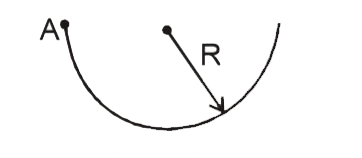Three identical rods are joined together to form an equilateral triangle frame. Its radius of gyration about an axis passing through a corner and perpendicular to the plane of the triangle is.
The correct Answer is:BB', AA'
To find the radius of gyration of an equilateral triangular frame formed by three identical rods about an axis passing through one corner and perpendicular to the plane of the triangle, we can follow these steps:
Step 1: Understand the Geometry
We have an equilateral triangle formed by three identical rods, each of length L. We will denote the vertices of the triangle as A, B, and C.
Step 2: Moment of Inertia of Rods
The moment of inertia I of a rod about an axis through one end and perpendicular to its length is given by:
I=13mL2
For rods AB and AC, both are attached to point A, so their moments of inertia about point A are:
IAB=IAC=13mL2
Step 3: Moment of Inertia of Rod BC
For rod BC, we need to use the parallel axis theorem because it is not directly rotating about point A. The distance from point A to the center of mass of rod BC is:
AP=Lsin60∘=√32L
The moment of inertia of rod BC about its center is:
IBC,center=112mL2
Using the parallel axis theorem:
IBC=IBC,center+md2
where d=AP=√32L:
IBC=112mL2+m(√32L)2
Calculating m(√32L)2:
=m⋅34L2=34mL2
Thus,
IBC=112mL2+34mL2=112mL2+912mL2=1012mL2=56mL2
Step 4: Total Moment of Inertia
Now, we sum the moments of inertia of all three rods:
I=IAB+IAC+IBC=13mL2+13mL2+56mL2
Converting 13mL2 to a common denominator:
=26mL2+26mL2+56mL2=96mL2=32mL2
Step 5: Radius of Gyration
The radius of gyration R is defined by the equation:
I=mR2
Thus,
32mL2=mR2
Dividing both sides by m:
32L2=R2
Taking the square root:
R=L√32=L√2
Final Answer
The radius of gyration about the axis passing through a corner and perpendicular to the plane of the triangle is:
R=L√2
We have an equilateral triangle formed by three identical rods, each of length L. We will denote the vertices of the triangle as A, B, and C.
The moment of inertia I of a rod about an axis through one end and perpendicular to its length is given by:
I=13mL2
For rods AB and AC, both are attached to point A, so their moments of inertia about point A are:
IAB=IAC=13mL2
For rod BC, we need to use the parallel axis theorem because it is not directly rotating about point A. The distance from point A to the center of mass of rod BC is:
AP=Lsin60∘=√32L
The moment of inertia of rod BC about its center is:
IBC,center=112mL2
Using the parallel axis theorem:
IBC=IBC,center+md2
where d=AP=√32L:
IBC=112mL2+m(√32L)2
Calculating m(√32L)2:
=m⋅34L2=34mL2
Thus,
IBC=112mL2+34mL2=112mL2+912mL2=1012mL2=56mL2
Now, we sum the moments of inertia of all three rods:
I=IAB+IAC+IBC=13mL2+13mL2+56mL2
Converting 13mL2 to a common denominator:
=26mL2+26mL2+56mL2=96mL2=32mL2
The radius of gyration R is defined by the equation:
I=mR2
Thus,
32mL2=mR2
Dividing both sides by m:
32L2=R2
Taking the square root:
R=L√32=L√2
The radius of gyration about the axis passing through a corner and perpendicular to the plane of the triangle is:
R=L√2
Similar Questions
Three identical rods, each of length L, are joined to form a rigid equilateral triangle. Its radius of gyration about an axis passing thorugh a corner and perpendicular to plane of triangle is
View SolutionMoment of inertia of a ring of mass M and radius R about an axis passing through the centre and perpendicular to the plane is
View SolutionThe moment of inertia of a copper disc, rotating about an axis passing through its centre and perpendicular to its plane
View Solution
Three rods each of mass m and length l are joined together to form an equilateral triangle as shown in figure. Find the moment of inertial of the system about an axis passing through its centre of mass and perpendicular to the plane of the particle.
View Solution
Three rods each of mass m and length l are joined together to form an equilateral triangle as shown in figure. Find the moment of inertial of the system about an axis passing through its centre of mass and perpendicular to the plane of the particle.
View SolutionTwo rings of same mass and radius R are placed with their planes perpendicular to each other and centre at a common point. The radius of gyration of the system about an axis passing through the centre and perpendicular to the plane of one ring is
View SolutionAn equilateral triangle ABC is cut from a thin solid sheet of wood .(see figure ) D,E and F are the mid-points of its sides as shown and G is the centre of the triangle.The moment of inertia of the triangle about an axis passing through G and perpendicular to the plane to the triangle is I0 If the smaller triangle DEF is removed from ABC , the moment of inertia of the remaining figure about the same axis is I. Then :

View SolutionA uniform rod of mass m is bent into the form of a semicircle of radius R. The moment of inertia of the rod about an axis passing through A and perpendicular to the plane of the paper is

View SolutionA uniform rod of mass m is bent into the form of a semicircle of radius R. The moment of inertia of the rod about an axis passing through A and perpendicular to the plane of the paper is

View SolutionThree identical rods, each of mass m and length l, form an equaliteral triangle. Moment of inertia about one of the sides is

View Solution
